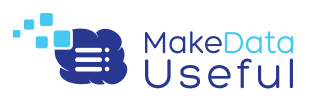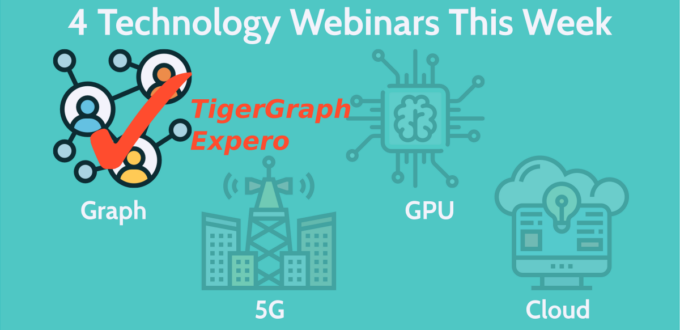As mentioned Monday, I have a week of different webinars lined up to watch and learn. If you missed the first two, I’m sure you can find it on-demand in the original links. Here is the first one I watched – from TigerGraph and Expero – with their key talking points for context and my takeaways added.
#1 – Energy Round Table with TigerGraph/Expero – Graph & ML
- Energy and IoT connected systems – why SQL and current ML approaches fall short
Anyone who knows how graph analytics works will understand that the table schema approach, with SQL querying, is not the best for understanding connectivity between objects. Sure you can put in a node-edges model into a table but you still need a way to query and analyze it effectively. Likewise, many pieces of enterprise infrastructure would be needed to handle each individual component of graph analytics (more on primary components later).
Incidentally, I cut my teeth on graph-like queries when learning SPARQLVerse and RDF store approaches (see my SPARQLVerse blog about computing network density). TigerGraph can import Jena, SPARQL, and RDF-based queries.
The webinar was focused on solutions for electrical energy grids, from both TigerGraph and their partner Expero. The physical assets on the ground are a perfect kind of network, that’s one of the properties that makes them so stable for those of us blessed with consistent power infrastructure. Both companies have either analytic solutions or frontend dashboarding tools available for the industry.
The idea of utility generating sources, substations, poles, lines, sundry circuit mechanics, IoT devices, buildings, etc., all draw out nicely as an interconnected set of nodes and edges. But when you try to analyze them, things get complicated quickly. The figure below, from a TigerGraph/Expero demo, shows a simple map view alongside the graph view in all its glory.

Understanding flow through this network is paramount but not simple when networks are large. This leads to three things are inherently different when dealing with graph analytics:
- Storage – by not using tabular structures or relational databases, a new type of store is required that organizes the data most effectively for the task at hand.
- Access – a type of query language to describe nodes, their properties, and the relationships between nodes is needed. There are a common set of analytics for graph that every graph database needs to have (and these go well beyond just friend-of-a-friend social connectivity!).
- Scalability – node-edge topology seems deceptively simple as a structure, but networks get big fast, especially when you have complex set of properties for every component. The database needs to scale and run in a distributed manner.
- How utilizing Graph can cut costs by 10%
- Drive real-time & predictive decisions while increasing velocity
For these two items, they showed how moving from a hodge-podge of legacy tools to a distributed real-time system allowed a national electrical grid to respond rapidly to predicted issues. They not only could see current state, but also added into their monitoring was the ability to see predicted data.
This is paramount for any kind of operational system like a national grid: you need history, predictions, real-time querying, and a tie-in to take effective action.
In the talk they describe multiple types of dashboards, for each type of use: planning, analytics, management, and data governance/security.
- Detailed review of ML methods and approaches combined with Graph to realize the accuracy increase
- Using Graph and ML to increase accuracy of Energy – Transmission – IoT determinations by 20%
When they started showing how they can apply many different models to the grid and see how it responds, that gets interesting. This allows them to run critical checks against the data to find the highest potential for failure, quicker, and with more accuracy.
By more effectively predicting maintenance needs early, or finding where the most critical infrastructure points are during an emergency… companies save a lot of time and a lot of money.
There is a great slide highlighting the specific capabilities/advantages of the platform with related benefits, below.

Try out TigerGraph Cloud for free in a few clicks. And see Expero, who builds on top of TigerGraph for some solutions. Let me know how you get on! Now to get ready for my next couple calls this week.
Need strategic help from a seasoned remote worker (before remote work was all the rage) who has extensive Silicon Valley database product experience and more? Drop me a message, I’m happy to discuss your latest data/product or launch challenge.
- Geography + Data - July 15, 2021
- DIY Battery – Weekend Project – Aluminum + Bleach? - January 17, 2021
- It’s all about the ecosystem – build and nurture yours - May 1, 2020
- Learnings from TigerGraph and Expero webinar - April 1, 2020
- 4 Webinars This Week – GPU, 5G, graph analytics, cloud - March 30, 2020
- Diving into #NoSQL from the SQL Empire … - February 28, 2017
- VID: Solving Performance Problems on Hadoop - July 5, 2016
- Storing Zeppelin Notebooks in AWS S3 Buckets - June 7, 2016
- VirtualBox extension pack update on OS X - April 11, 2016
- Zeppelin Notebook Quick Start on OSX v0.5.6 - April 4, 2016


No Comments Yet